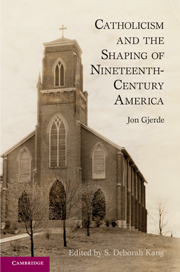Book contents
2 - The Catholic Conundrum
Published online by Cambridge University Press: 05 June 2012
Summary
The question now pressing itself upon the American people is, to determine their Religion, as our fathers did the character of their political institutions. . . . With the free exertion of Reason, with the natural impulses of our instincts, and with the silent influences of our noble institutions, the American people will rise in the strength of its manhood and proclaim itself Catholic.
Isaac Hecker, 1857In 1836, John Hughes, who would later become archbishop of New York City, and John Breckinridge, secretary and general agent of the Board of Education of the Presbyterian Church, engaged in a series of debates in Philadelphia considering whether either Roman Catholicism or Presbyterianism was inimical to civil or religious liberty in the United States (see Fig. 3). The debate was long in coming. As early as 1832, Breckinridge tendered a challenge in the periodical Christian Advocate to anyone who wished to debate whether the “Protestant Religion” was the “Religion of Christ.” Hughes, who had been ordained to the priesthood only six years before and who would become a towering figure in American Catholicism, took up the challenge. Once they agreed on the ground rules of the debate, each developed his arguments, which were published in sectarian journals beginning in 1833. Three years later, Breckinridge and Hughes met in another series of debates, the content of which was also published.
- Type
- Chapter
- Information
- Publisher: Cambridge University PressPrint publication year: 2011

